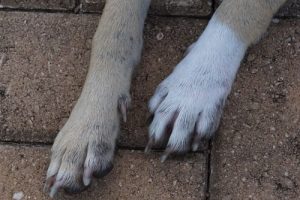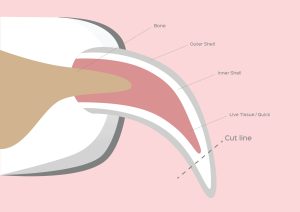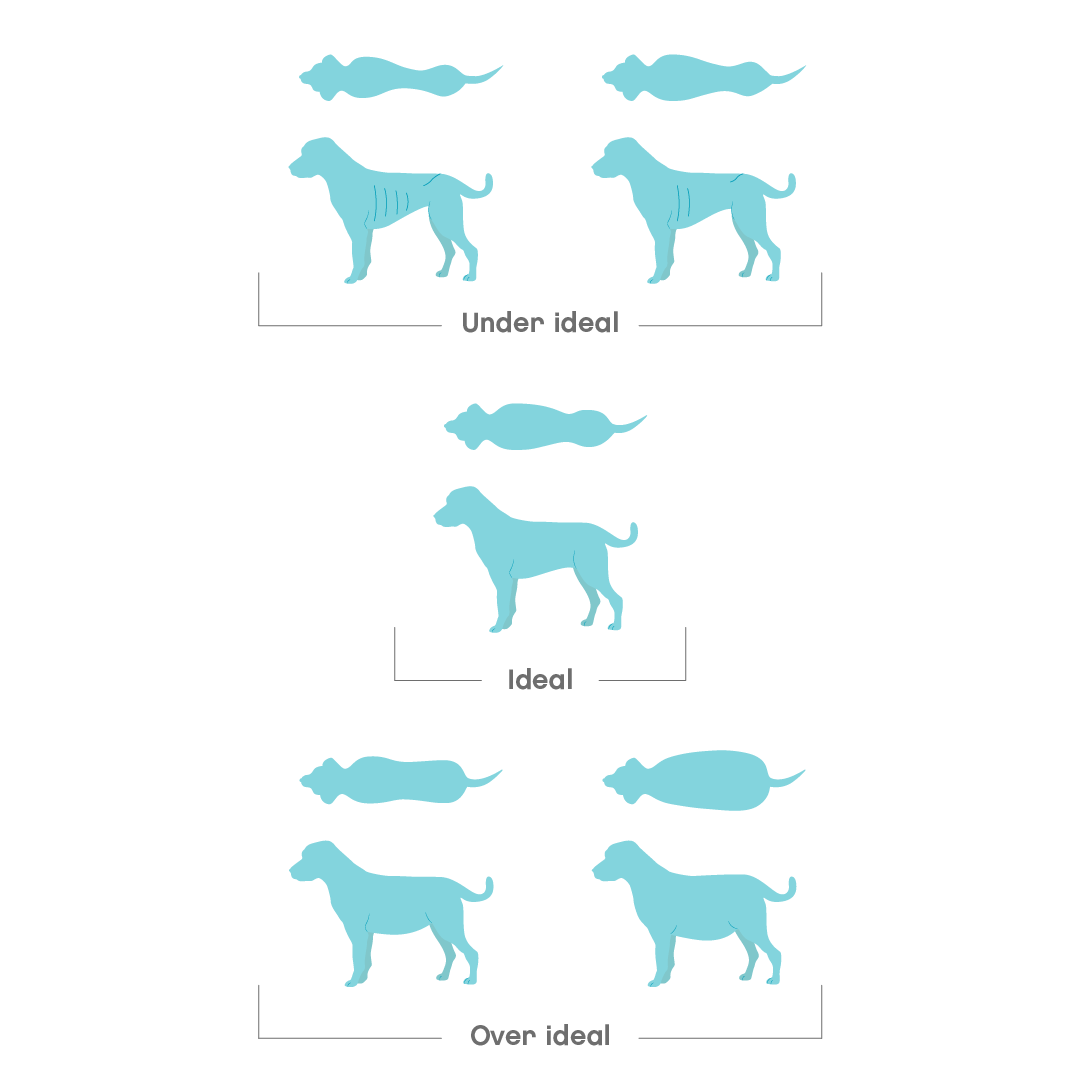Nail problems in dogs are common and have many different causes. Most nail problems are straightforward to diagnose and do not need emergency treatment. The prognosis for nail problems is generally good, though some may need life-long treatment.
The most common causes of nail problems are trauma, allergies, and infections. Dogs of any age can develop nail problems. Speak to a vet if you have any concerns about your dog’s nails.
Overview
What are nail problems in dogs?
Most dogs have five nails on their front feet and four on their back feet. The extra nail that is higher up than the rest is known as the dew claw. Some dogs have dew claws on their back legs too.

The nail area consists of the bone, quick, outer shell, and nail bed. The quick is the part with blood and nerve supply. This area is extremely sensitive and often bleeds if damaged. Luckily, the bleeding will usually stop with gentle pressure.

- Dog nail anatomy
The most common causes of nail problems include:
- Broken or torn nails due to trauma
- Ingrown nails: this happens when the nail curls around on itself and starts to grow into the paw pad.
- Infection, usually bacterial or fungal.
- Bacterial infections are usually secondary due to an underlying allergy, an ingrown nail, or trauma. They may also occur with conditions such as diabetes or hypothyroidism.
- Ringworm is a fungal infection that can cause nail problems.
- Immune-mediated disease: when the body’s own immune system starts to attack healthy cells.
- Systemic lupoid onychodystrophy (SLO) is the most common auto-immune problem that affects the nails in dogs. The nails are usually very brittle and fall out with this disease.
- Allergies, food and environmental
- Nutritional problems, such as a zinc deficiency
- Tumours: the most common are squamous cell carcinoma, melanoma, osteosarcoma, and mast cell tumours.
Some causes of nail problems are mild and easy to treat from home, whereas others may need short-term prescription medication or life-long treatment. Speak to a vet if your dog shows any symptoms of nail disease. Our Joii vets are available 24 hours a day for advice.
Symptoms
Symptoms of nail problems in dogs
Signs of nail problems in dogs may include one or more of the following:
- Limping and difficulty walking
- Licking, chewing or biting at the nail or paw
- Pain around the nail or paw
- Discharge, such as pus or blood around the nail
- Swelling or redness around the nail bed or paw
- Broken, thickened or misshapen nails
- Nails that are brittle and break easily
- Changes to the colour of the nail
Risk
Are some dogs more at risk of nail problems than others?
Nail problems can happen in any dog, regardless of age, breed, or lifestyle. However, there are risk factors for some of the causes:
- Very active dogs are more likely to get torn or broken nails
- Less active dogs are more prone to ingrown nails
- German Shepherds, Setters and Rottweilers are more susceptible to the immune-mediated disease SLO
- Zinc deficiencies are more common in Huskies and Malamutes and tend to affect giant dog breeds more often than smaller breeds
Diagnosis
How are nail problems diagnosed in dogs?
The first step in diagnosing nail problems in dogs is to have a full clinical exam with a veterinarian. It is important to determine what the next step is and whether medication or further testing are needed. Further tests include:
- Examination under sedation or general anaesthesia
- Skin or nail scrapes to check for parasites or fungal infections
- Samples of any discharge for culture or cytology
- Biopsy of the nail or skin around it
- Investigations into allergies, such as a diet trial or intradermal skin testing
- Blood tests to check for underlying diseases such as diabetes or hypothyroidism
- Imaging, such as x-rays or CT. This is often the case if a tumour is suspected, to check for spread
Vet treatment
What’s the treatment for nail problems in dogs?
Broken nails due to trauma can sometimes be treated from home.
Vet treatments may include one or more of the following:
- Clipping or removing the damaged nail, usually under sedation
- Cleaning wounds
- Antimicrobials, such as antibiotics or antifungal medication
- Pain relief
- Anti-inflammatory medication
- Bandaging the paw
- Surgery, such as toe amputation, if a tumour is involved
- Immunosuppressants, vitamins and omega fatty acids may be used for immune-mediated conditions
- Specific treatment for underlying diseases such as zinc deficiencies, allergies, or diabetes. Further treatments, such as chemotherapy or radiation, may be possible for tumours.
Home treatment
How to look after a dog with nail problems at home
Broken nails can often be treated from home if:
- The nail has come off on its own
- There is no sign of infection or pain
It’s always best to speak with a vet to decide if this is in the best interest of your dog and discuss how to keep the area clean.
- Prevent your dog from biting or licking the nail area by using a buster collar or pet boot
- Allow your dog to rest until the symptoms improve
- Make sure to keep the affected area clean and dry at all times
- Give any medication as prescribed by your vet
- Supplements such as omega oils or vitamins may be recommended
- Topical disinfectants, such as a foam or wipes may be used for mild infections
Prevention
Tips on how to prevent nail problems in dogs
- Keep your dog’s nails at the appropriate length; this may involve regular trips to get them trimmed by a professional
- Make sure your dog is on a complete diet to avoid deficiencies of essential vitamins and minerals
- Avoid trimming your dog’s nails yourself unless you have been shown by a vet or nurse how to do it correctly
- Check your dog’s paws and nails regularly, at least 1-2 times per week, for any abnormalities. It’s important to get them used to this when they are puppies.
- Keep your dog up-to-date with regular parasite preventatives
- Keep your dog at a healthy body condition
Body Condition Score (BCS) is a scale that gives a practical evaluation of the fat coverage of your dogs body. By checking how easy or not it is to feel certain bony areas of the body, a score is then produced. There are several scales, from 1 to 5 or 1 to 9. The ideal body condition lies in the middle, so either 3/5 or 5/9. The body areas normally checked for fat coverage are: 1. ribs and spine 2. hips and shoulders 3. waist Here are a few tips on how to do it. With your pet in a standing position:
Body Condition Scoring (BCS) in dogs

Are my family at risk of catching nail problems from my dog?
Of the most common types of nail problems listed above, the only one that can be transferred from dogs to humans is ringworm. If your dog has been diagnosed with ringworm, your vet and GP will be able to guide you on how to prevent its spread.
When to worry
When you should be worried about nail problems in dogs
Seek help from a vet if:
- Your dog has pus around the nail
- Your dog develops a lump on their toe
- Your dog’s nails are falling out
- Your dog is in pain
Call us and speak to one of our Joii vets if:
- Your dog has torn their nail and you are unsure what to do next
- You have any questions about clipping your dog’s nails
- You have any questions about your dog’s nutrition








